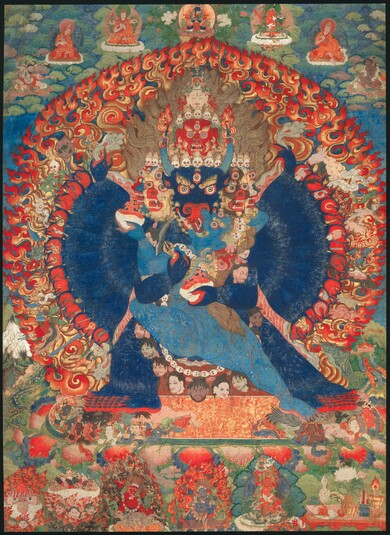
Item: Vajrabhairava (Buddhist Deity) - with consort
རྡོ་རྗེ་འཇིགས་འབྱེད།
金刚大威德(佛教本尊)
(item no. 12783)
| Origin Location | Tibet |
|---|---|
| Date Range | 1700 - 1799 |
| Lineages | Gelug and Buddhist |
| Size | 177.50x129.50cm (69.88x50.98in) |
| Material | Ground Mineral Pigment on Cotton |
| Collection | Private |
Notes about the Central Figure
Classification: Deity
Appearance: Animal-Feature
Gender: Male
Vajrabhairava (Tibetan: dor je jig je. English: the Vajra Terror): wrathful form of the peaceful bodhisattva Manjushri from the classification of Anuttarayoga Tantra. Dated Amdo 1740. (The measurement above is without the brocade textile mount).
At the top center is Vajradhara Buddha and consort. At the right side is Arapachana Manjushri along with three Gelug teachers with yellow hats and two mahasiddha figures.
At the bottom center is blue 'Inner' Yama Dharmaraja with Vaishravana to the right and red 'Secret' Yama Dharmaraja on the left side.
Jeff Watt [added 2024]
Sadhana Description:
Shri Vajra-mahabhairava (dpal rDo-rje' jigs-byed chen-po), dark blue, with nine faces, thirty-four arms and sixteen legs, abiding in pratyalidha posture (right legs bent). Capable of devouring the three worlds, he is shouting 'Haha' and has rolled-up tongue, bared fangs and a frown. Beside the frown, his eyebrows and eyes blaze like the fire at the time of destruction. His pale yellow hair streams upwards. Threatening the worldly and supermundane gods, he terrifies even the terrible, roaring like thunder the great sound of PHEM and eating human blood, grease, marrow and fat. He is crowned with five frightful dry skulls and adorned with a skull garland of fifty fresh heads, a black snake as scared thread, a circlet of human bone, and earrings and the other ornaments of bone. He is naked of body, with huge belly. His sex stands erect. His eyebrows, eyelashes, beard and body hairs blaze like the fire at the end of time. His principle face is a buffalo's, black, extremely wrathful and with sharp horns. Above this, midway between the two horns, is a red face, most frightful, with blood dripping from its mouth. Above this is the yellow face of Manjushri, just a little wrathful, adorned with the ornaments of a young man, with five locks on the crown of his head. The main face under the right horn is blue, that to its right red, and that to its left yellow. The main face under the left horn is white, that to its right smoke-colored, and that to its left black. These faces are extremely wrathful. All nine faces are three-eyed. The first pair of arms hold a fresh elephant-skin, stretched out with its head on the right and hands and feet on the left, showing the hairs outside. The remaining right hands hold 1. a knife, 2. a dart (bhindipala), 3. a wooden pestle, 4. a knife with a wavy blade, 5. a harpoon, 6. An axe, 7. a spear, 8. an arrow, 9. a hook. 10. a club, 11.a khatvanga, 12. a wheel, 13. a five-pointed vajra, 14. a vajra hammer, 15. a sword and 16.a damaru. The left hold 1. a blood-filled skull, 2. a Brahma's head, 3. a shield, 4. a foot, 5. a noose, 6. a bow, 7. entrails, 9. a hand, 10. a shroud, 11. a man impaled on a stake, 12. a brazier, 13. a piece of a skull, 14. a threatening, forefinger, 15. a triple banderole and 16. a fan (rlun ? ras, also 'prayer-flag'). His feet tread on 1. a human being, 2. a buffalo, 3. an ox, 4. an ass, 5. a camel, 6. a dog, 7. a sheep and 8. a fox (or jackal) his left feet on 1. a vulture, 2. an owl, 3. a ravan, 4. a parrot, 5. a hawk, 6. a garuda, 7. a domestic fowl and 8. a swan. He also tramples beneath his feet Brahma, Indra, Visnu, Rudra, Six-faced Kumara (= Karttikeya), Vinyaka (Ganesa), Candra and Surya, lying face down. In this manner he abides amid an intensely blazing mass of fire. Deities of Tibetan Buddhism, Wisdom Publications, 2000. Translated by Martin Willson from the sadhana text of Phabongkha Dechen Nyingpo (1878-1941): biographical reference.
Buddhist Deity: Vajrabhairava Main Page
Collection: Christie's, New York, March, 2024 (Painting, Curator's Selection)
Collection: Christie's, New York, March, 2024 (Painting)
Buddhist Deity: Vajrabhairava (Late Painting Masterworks)
Buddhist Deity: Vajrabhairava (Painting Masterworks)
Collection: Sothebys, Painting (March, 2013; New York)
Iconography: Buddhist Art & Tantric Iconography
Copyright © 2025
Himalayan Art Resources Inc.
Images Provided Courtesy of Private Collections
